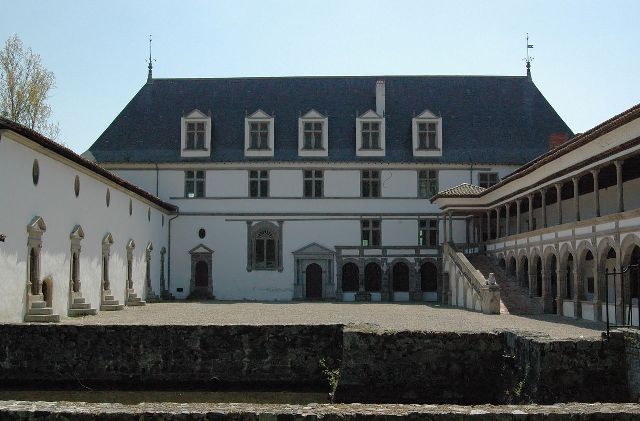Château de la Bastie d'Urfé

Château de la Bastie d'Urfé Photo - lapin.lapin -
Wikipedia - lic. under CC BY-SA 2.0

Castle Facts:
Location: Saint-Etienne-le-Molard, in the Loire departement of France (Rhone-Alpes Region).
Built: 15th-18th century.
Condition: In good condition.
Ownership / Access: Owned by a private company.
ISMH Reference Number: PA00117605
Notes: Château de la Bastie d'Urfé is a castle of Drill, located in Saint-Étienne-le-Molard, in the Loire, in Auvergne-Rhône-Alpes.A monastic grange installed on the banks of the Lignon by the monks of the priory Champdieu is causing the field of Built in the eleventh century. It then becomes a fortified house with its drawbridge and moat. The family d'Urfé, down from its mountain fortress (now dubbed the "Cornes d'Urfé") in Champoly, near Saint-Just-en-Chevalet, moved to the Built from the thirteenth century.Built in the fifteenth century, the family mansion of the Bastie, a building originally medieval style has subsequently been transformed by Claude d'Urfé (1501-1558), Ambassador Francis in Rome for the Council of Trent then governor of the Dauphin. He was inspired by his stay in Italy and royal achievements to arrange In 1535 his remains a jewel of the Italian Renaissance and French (new art of the sixteenth century) and become the flagship of Drill.
Claude d'Urfe wanted to express through architecture and scenery of Built, different ideas: his love for his wife, his passion for the arts and for knowledge and his philosophical thought. He ordered to great artists to embellish.Located beside the Lignon du Forez, this is Honore d'Urfe, grand-son of Claude, spent part of his youth in this castle and wrote L'Astree first novel literature River.Built in the fifteenth century, the family mansion of the Bastie, a building originally medieval style has subsequently been transformed by Claude d'Urfé (1501-1558), Ambassador Francis in Rome for the Council of Trent then governor of the Dauphin. He was inspired by his stay in Italy and royal achievements to arrange In 1535 his remains a jewel of the Italian Renaissance and French (new art of the sixteenth century) and become the flagship of Drill.
Claude d'Urfe wanted to express through architecture and scenery of Built, different ideas: his love for his wife, his passion for the arts and for knowledge and his philosophical thought. He ordered to great artists to embellish.
Located beside the Lignon du Forez, this is Honore d'Urfe, grand-son of Claude, spent part of his youth in this castle and wrote L'Astree, the first novel in French literature River.Moreover, we find real places surrounding the castle in this book puisqu'Honoré d'Urfe placed the Built and around the center of his novel. They can be found from the windows of this house a framework discussed by the writer: the countryside, the banks of the Lignon, the Monts du Soir and Drill. In the park, the Fountain of Love Truth remains, similar to Adamas had erected by Celadon.In 1836, the Bastie d'Urfé is purchased by Caroline "to" Lagrange (1806-1870), daughter of Count Joseph Lagrange (1763-1836), Duchess of Cadore, wife of Louis Alix de Champagny Nompère. La Bastie d'Urfé could be saved because it is for Prosper Mérimée for a ranking. But it was in vain.
How To Get To Château de la Bastie d'Urfé (Map):
Château de la Bastie d'Urfé Links:
Château de la Bastie d'Urfé On Wikipedia
Have You Visited This Château? Please Comment Below:




